Compared
NEW: Best 70-200mm f/2.8 Lenses Compared.
This Tamron is half the price, and optically just as good as the lenses from Canon and Nikon.
What you lose for paying only half as much is that this Tamron is built only to good consumer levels, while the Nikon 70-200mm f/2.8 FL VR FX and Canon 70-200mm f/2.8 L IS II are built to extraordinary professional standards with mostly metal barrels and metal filter threads. Nikon and Canon’s 70-200/2.8s are built to withstand a lifetime of full-time professional environmental and physical abuse, while this Tamron is designed for normal people who take care of their equipment.
Every non-camera-brand product has the potential to be, or become, incompatible with your camera. While it probably will be perfect with your camera today (and if it’s not and you get yours from an you can send it back for a 100% cash refund), there’s no telling if it will be compatible with whatever camera you might buy 10 years from now. I’m still using my Canon and Nikon 80-200mm f/2.8 lenses that I bought back in the 1980s and 1990s with my newest digital cameras, but no one can be sure if this Tamron lens will work with cameras 10 years from now. While off-brand makers all smile and try to reassure you today that they’ll be around in the future to update lenses, experience has shown that these makers just walk away when it comes to trying to update 10 year old lenses.
Let’s be serious: The Nikon 70-200mm f/2.8 FL VR FX costs $2,800 as I write this. That’s $1,500 more than this lens. You could buy this Tamron today, and if in ten years it stops working, buy another brand-new version from Tamron and still be way ahead.
Specifications
Name
Tamron calls this the Tamron SP 70-200mm f/2.8 Di VC USD G2:
SP: Special Performance; Tamron has called most of their lenses this since at least the 1970s.
Di: Works on digital cameras — so?
VC: Vibration control (Image Stabilization).
USD: Ultrasonic Silent Drive autofocus motor.
G2: Tamron’s second 70-200/2.8 VC.
Also has:
∅77: 77mm filter thread.
Optics
23 elements in 17 groups.
5 LD Low Dispersion elements, which help reduce secondary axial chromatic aberration.
1 XLD Extra-Low Dispersion elements, which help reduce secondary axial chromatic aberration.
No aspherical elements.
No high refractive-index elements.
Fluorine coating to resist dirt and smudges.
Internal zoom; nothing moves externally as zoomed.
Nikon: FX and DX (digital cameras only).
Canon: Full-Frame, and APS-C.
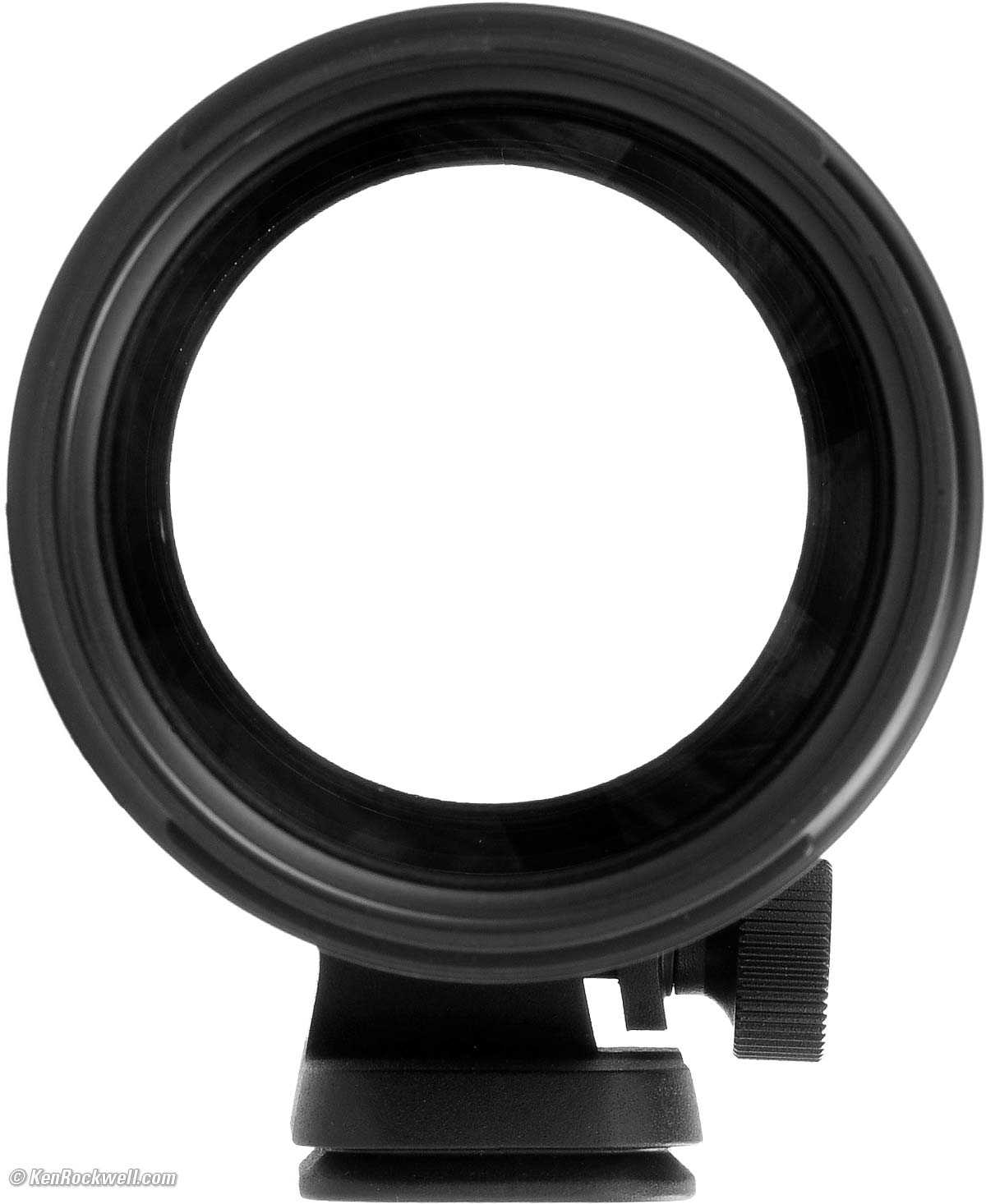
Tamron 70-200mm f/2.8 VC G2. bigger.
9 rounded blades.
Stops down to f/22.
Focal Length
70~200mm.
When used on a Nikon DX camera, it sees the same angles of view as a 105~300mm lens sees when used on an FX or .
When used on a Canon APS-C camera, it sees the same angle of view as a 112~320mm lens sees when used on a full-frame or
See also Crop Factor.
APS-C
22.3º ~ 8º diagonal.
Internal focus.
No external movement as focused, so no air or dust is sucked in.
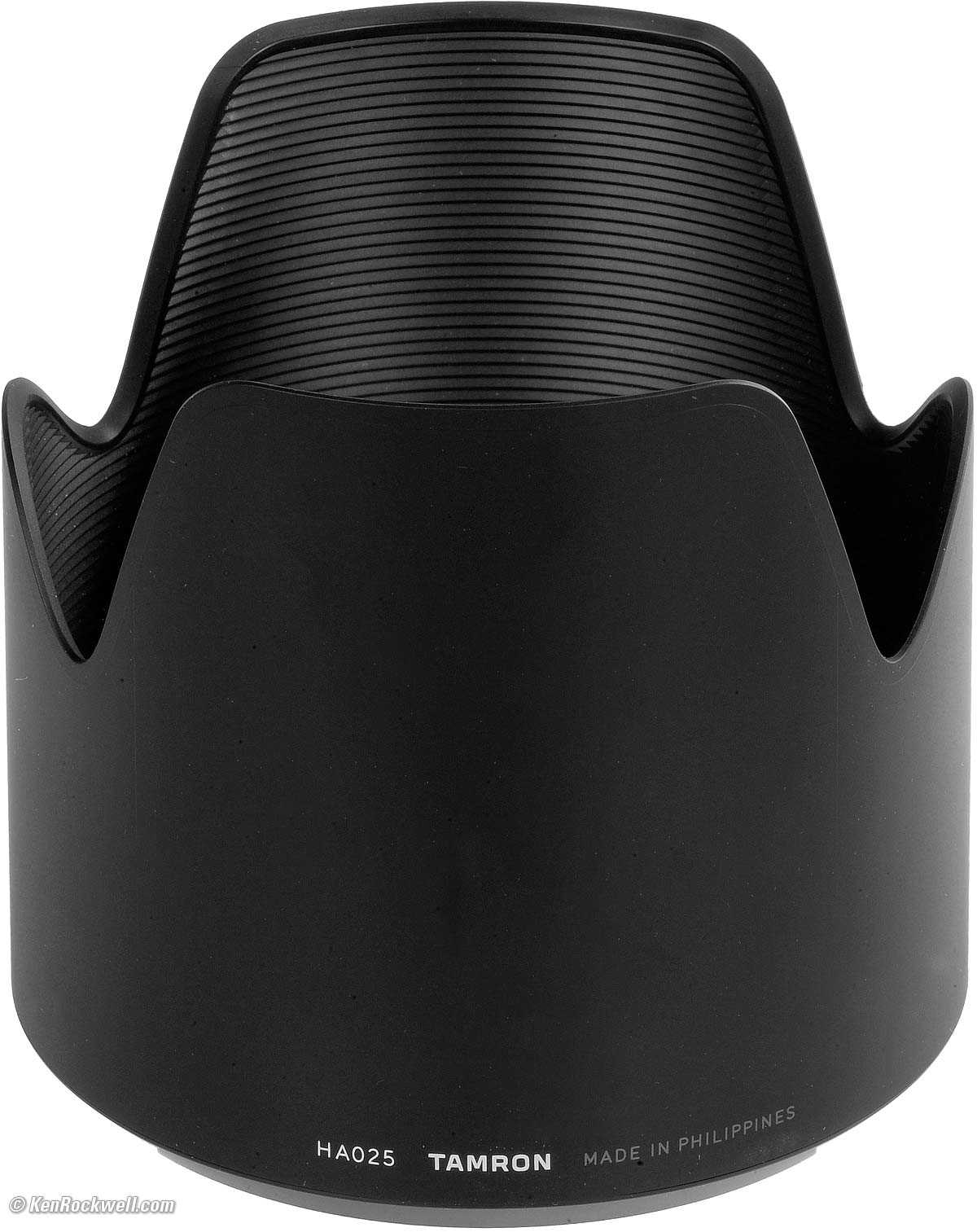
Tamron HA025 hood for 70-200mm. bigger.
Size
3.5″ maximum diameter × 7.5″ extension from flange.
88 mm maximum diameter × 191.3 mm extension from flange.
Canon
3.5″ maximum diameter × 7.6″ extension from flange.
88 mm maximum diameter × 198.3 mm extension from flange.
Weight
52.095 oz. (1,476.9g) actual measured weight, Nikon.
52.4 oz. (1,485 g) specified for Nikon.
52.9 oz. (1,500 g) specified for Canon.
Quality
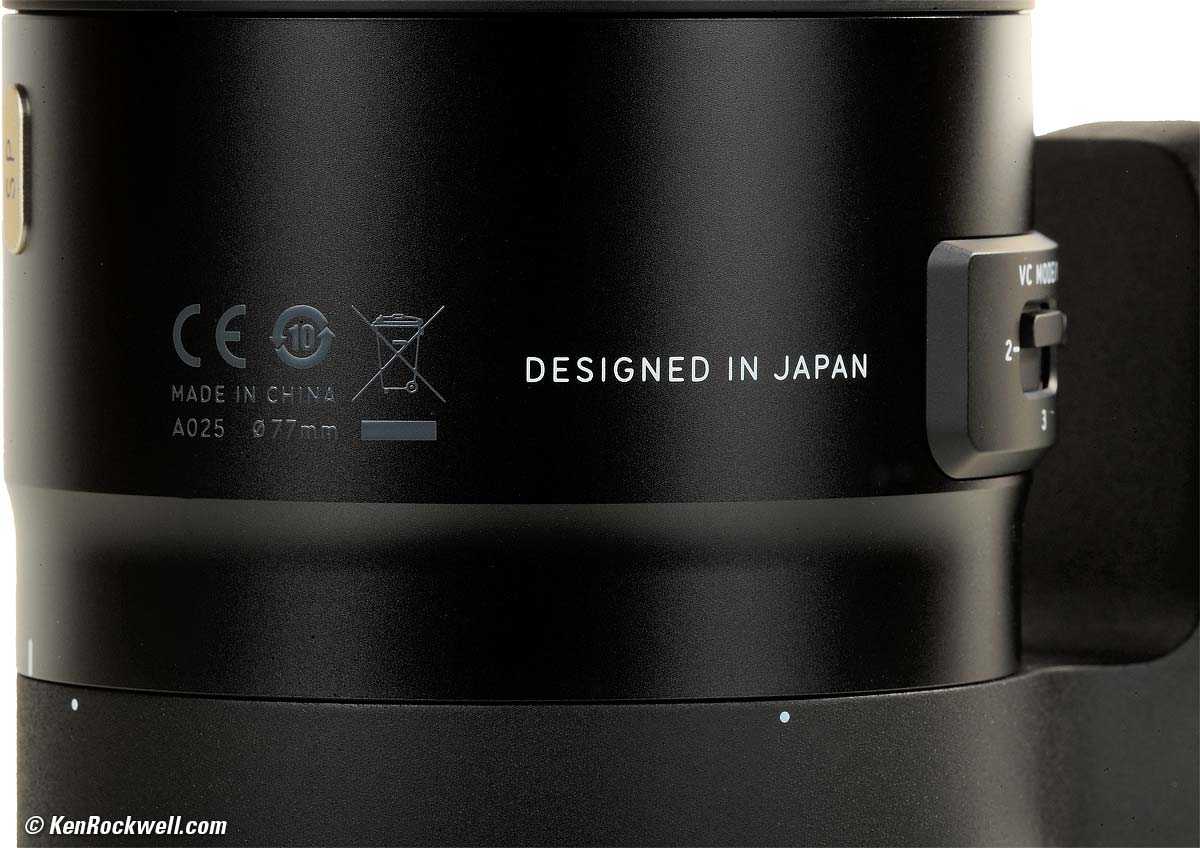
Made in China («Designed in Japan»). bigger.
MADE IN CHINA.
Tamron shamefully hides MADE IN CHINA in little dark-gray letters while deceptively putting DESIGNED IN JAPAN in big white letters.
Canon: AFA025C-700.
Nikon: AFA025N-700.
$1,299, April 2018.
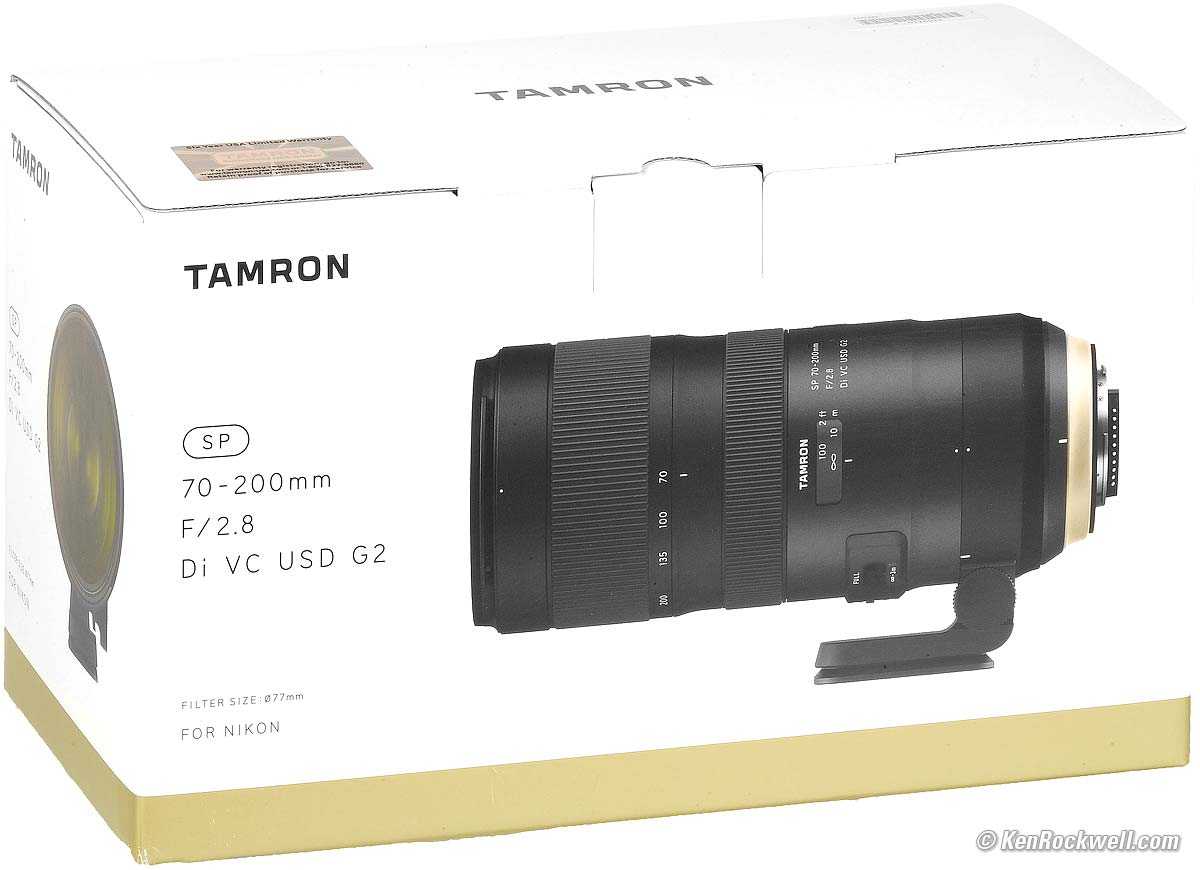
Tamron 70-200mm f/2.8 VC G2. bigger.
Specifications
Name
Tamron calls this the Tamron SP 70-200mm f/2.8 Di VC USD G2:
SP: Special Performance; Tamron has called most of their lenses this since at least the 1970s.
Di: Works on digital cameras — so?
VC: Vibration control (Image Stabilization).
USD: Ultrasonic Silent Drive autofocus motor.
G2: Tamron’s second 70-200/2.8 VC.
Also has:
∅77: 77mm filter thread.
Optics
23 elements in 17 groups.
5 LD Low Dispersion elements, which help reduce secondary axial chromatic aberration.
1 XLD Extra-Low Dispersion elements, which help reduce secondary axial chromatic aberration.
No aspherical elements.
No high refractive-index elements.
Fluorine coating to resist dirt and smudges.
Internal zoom; nothing moves externally as zoomed.
Nikon: FX and DX (digital cameras only).
Canon: Full-Frame, and APS-C.
Tamron 70-200mm f/2.8 VC G2. bigger.
9 rounded blades.
Stops down to f/22.
Focal Length
70~200mm.
When used on a Nikon DX camera, it sees the same angles of view as a 105~300mm lens sees when used on an FX or .
When used on a Canon APS-C camera, it sees the same angle of view as a 112~320mm lens sees when used on a full-frame or
See also Crop Factor.
APS-C
22.3º ~ 8º diagonal.
Internal focus.
No external movement as focused, so no air or dust is sucked in.
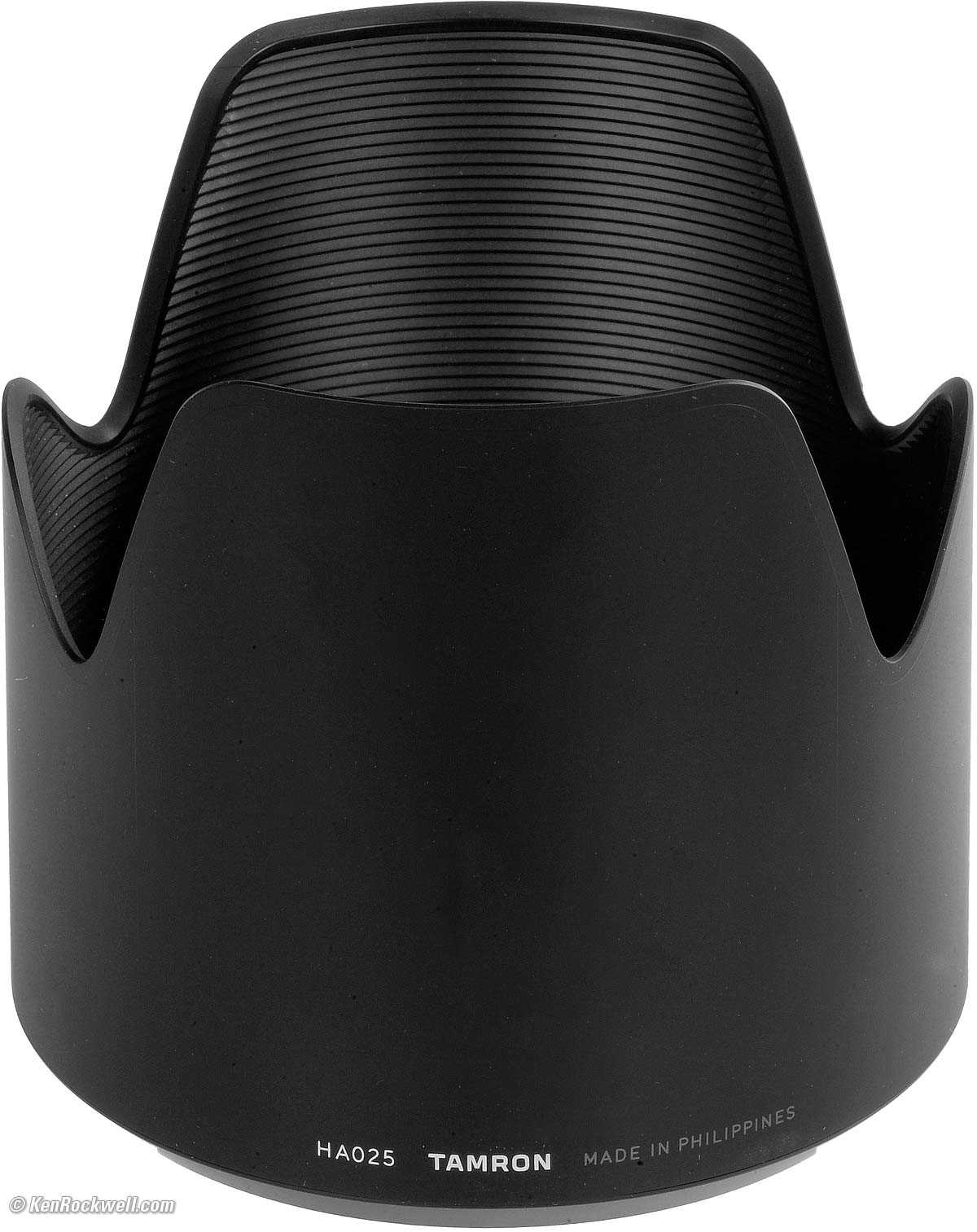
Tamron HA025 hood for 70-200mm. bigger.
Size
3.5″ maximum diameter × 7.5″ extension from flange.
88 mm maximum diameter × 191.3 mm extension from flange.
Canon
3.5″ maximum diameter × 7.6″ extension from flange.
88 mm maximum diameter × 198.3 mm extension from flange.
Weight
52.095 oz. (1,476.9g) actual measured weight, Nikon.
52.4 oz. (1,485 g) specified for Nikon.
52.9 oz. (1,500 g) specified for Canon.
Quality
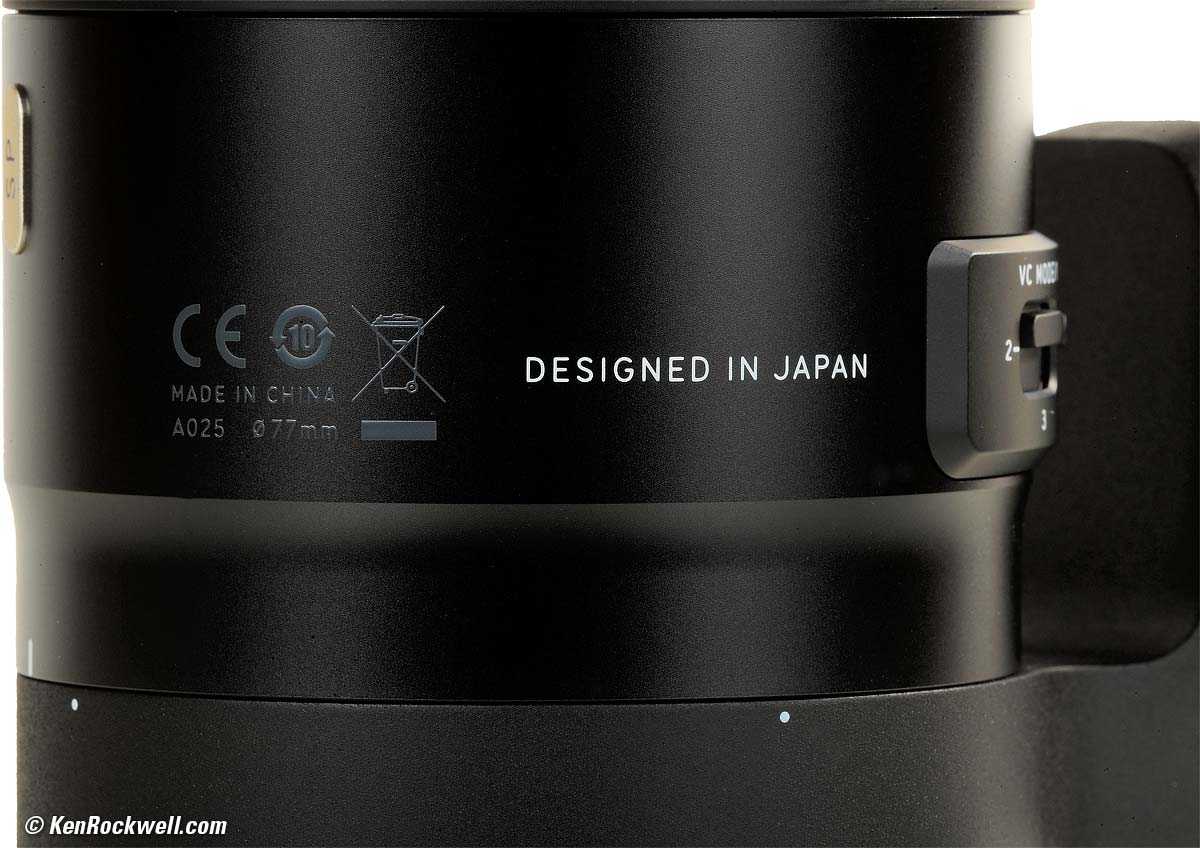
Made in China («Designed in Japan»). bigger.
MADE IN CHINA.
Tamron shamefully hides MADE IN CHINA in little dark-gray letters while deceptively putting DESIGNED IN JAPAN in big white letters.
Canon: AFA025C-700.
Nikon: AFA025N-700.
$1,299, April 2018.
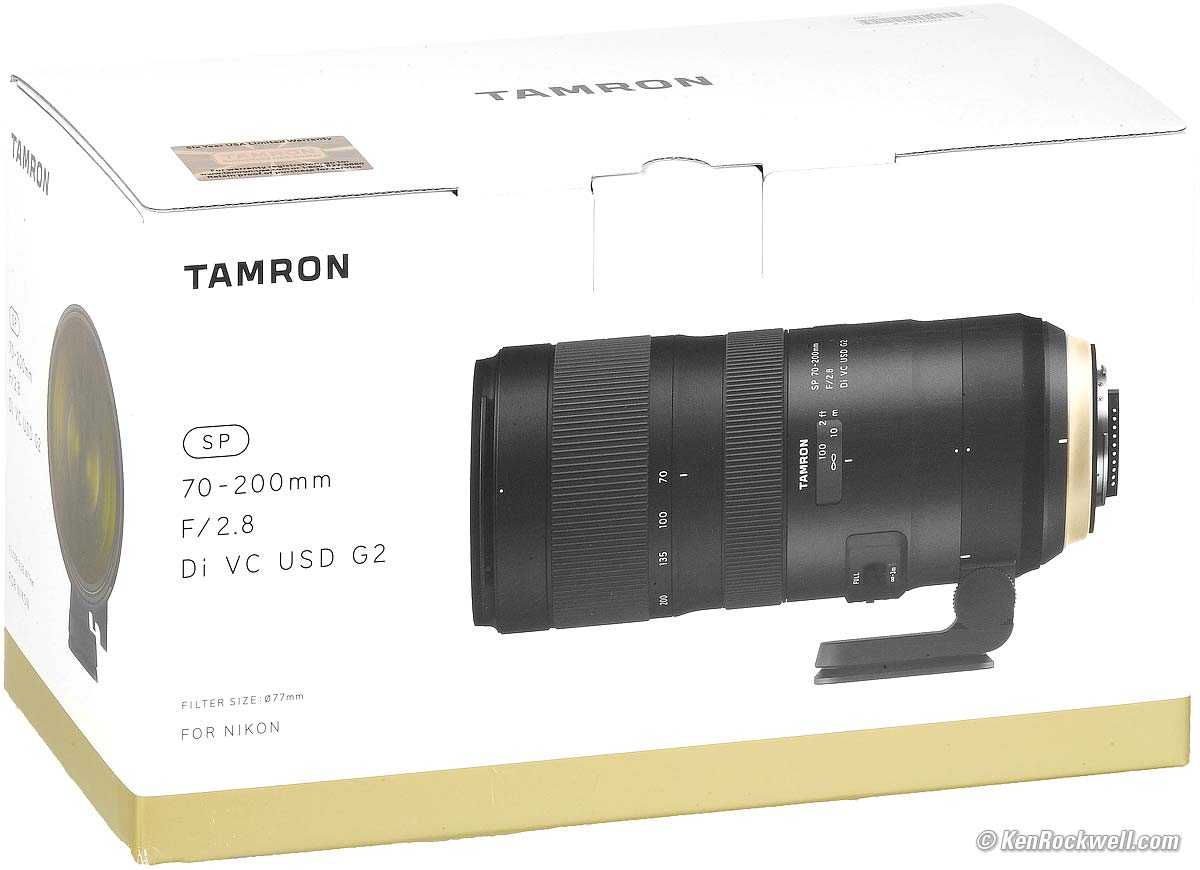
Tamron 70-200mm f/2.8 VC G2. bigger.
Usage
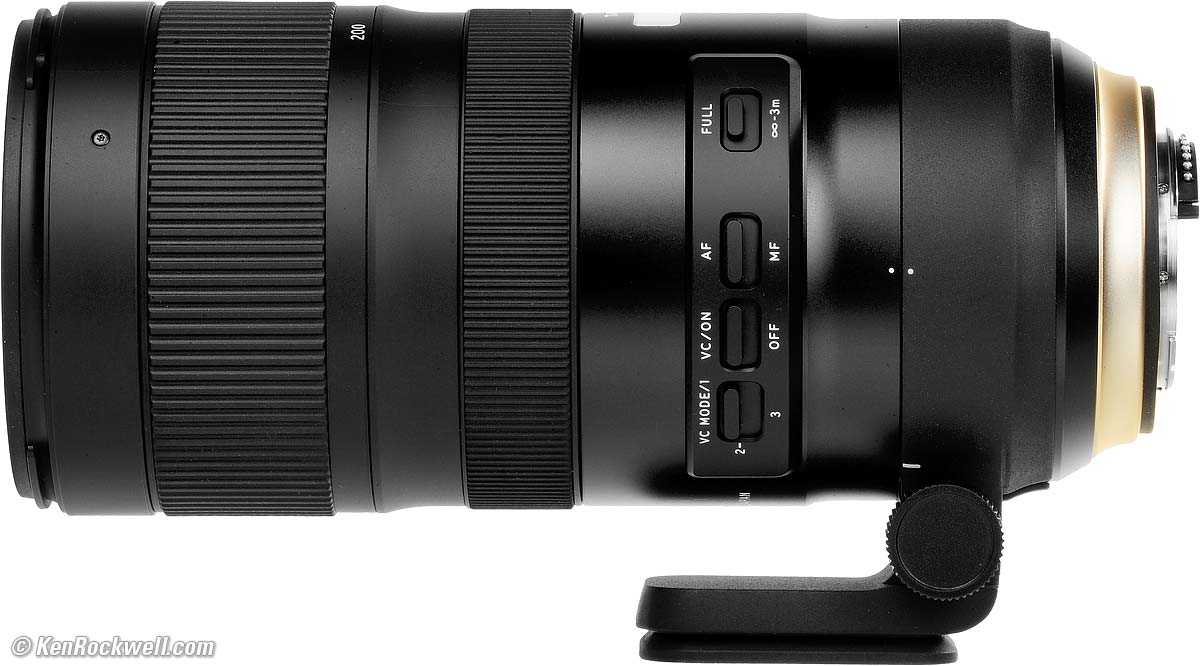
Tamron 70-200mm f/2.8 VC G2. bigger.
VC MODE/1
This selects what kind of Image Stabilization you’re getting.
Mode 1, the top position, is the usual setting. It stabilizes your photos, as well as your viewfinder image.
Mode 2 is for panning.
Mode 3 offers even better picture stabilization than Mode 1, but it may make the viewfinder image look shakier because it’s optimizing itself to stabilize the captured image instead of also stabilizing the pre-exposure viewfinder image.
Use Mode 1, unless you don’t mind a shakier viewfinder image and aren’t getting the results you want in Mode 1. Mode 2 is only for panning.
VC / ON (OFF)
This activates or deactivates Image Stabilization.
Always leave it on (VC/ON), except if you are on a sturdy tripod (OFF).
AF (MF)
This selects auto (AF) or manual focus (MF).
Always leave it at AF, at which setting you can move the focus ring at any time for instant override.
Only set it to MF if you want to lock it in manual focus.
FULL / ∞-3m
This is a focus limiter that, in the ∞-3m setting, doesn’t let the lens focus any closer than 3 meters (10 feet).
Leave this at FULL, unless the lens is racking all the way in and out hunting for the subject, which you know is at least 3m/10′ away. I doubt you’ll ever need this, unless you’re shooting distant things through an obstruction.
Design
The 70-200mm ($1,299.00 at Amazon) doesn’t deviate in size or shape from other takes on the design. It measures 7.6 by 3.5 inches (HD), weighs 3.3 pounds, and supports 77mm front filters. The lens features an internal zoom design, so it doesn’t change length when zooming.
Our Experts Have Tested 35 Products in the Lenses Category This Year
Since 1982, PCMag has tested and rated thousands of products to help you make better buying decisions. See how we test.
A long lens changes the center of gravity of your camera system, so there’s an integrated, rotating tripod collar near the 70-200mm’s base—you’ll want to use its tripod thread when mounting to a support system in order to better distribute the weight of camera and lens. The tripod foot is compatible with the Arca-Swiss quick release system.
Similar Products
The lens is finished in black, with a sturdy metal barrel. It’s sealed against dust and moisture, making it an ideal match for pro-grade cameras. The front element features a fluorine coating, which repels moisture and oils—it makes it easy to clean off an inadvertent thumbprint, and makes it more practical to use the lens in the rain. A hood is included; it’s reversible for storage. Tamron sells the 70-200mm for Canon and Nikon SLRs.
There are a few control switches, all located about mid barrel. A focus limiter can be set to allow autofocus across the entire range, or only from 10 feet (3 meters) to infinity. The AF/MF switch changes the focus mode, and there are two switches to set the Vibration Compensation (VC) system. One simply turns it on or off, and a second sets it to mode 1, 2, or 3. Mode 1 should be used for most situations, while Mode 2 is ideal for shots when you’re panning the camera left or right to track a moving subject. Mode 3 offers the most extreme compensation—Tamron claims it’s good for 5 stops—but only activates the system when an image is captured, which can make the image in the viewfinder appear a bit shaky when framing a shot, and can slightly alter your framing.
In Mode 1 I was able to get crisp handheld shots when seated and bracing myself at speeds as low as 1/6-second, but could only manage the same quality when standing at speeds of 1/30-second or shorter. Switching to Mode 3 didn’t net better results when I was bracing myself, and I actually felt the lack of in-viewfinder stabilization was a detriment. But when standing on two feet, I netted about an extra stop of compensation, getting consistently solid results at 1/15-second. You’ll probably want to leave the VC system in Mode 1 or 2 most of the time, but it’s good to know that Mode 3 is there when you need it.
Leaving the switches in place can be an issue, though. They’re the same design used by the Tamron SP 150-600mm F/5-6.3 Di VC USD G2 ($1,299.00 at Amazon) . The toggles are wide and comfortably adjusted, but they jut out from the lens barrel to the point where they’ll move if the lens brushes up against your body, or if they snag on a divider when putting the lens in or taking it out of your bag. Some gaffer tape may be in order if you’re working a wedding and don’t want to accidentally switch out of your preferred mode.
Two big rings control focus and zoom. Both are covered in ribbed rubber, which makes them comfortable to turn. The zoom ring sits right behind the front element and is marked at 70, 100, 135, and 200mm. The focus ring is just behind it, next to a cutout window that shows the set focus distance in feet and meters.
The lens focuses as close as 3.1 feet (0.95-meter). At 200mm it has a 1:6.1 reproduction rate, projecting subjects at about one-sixth life-size (0.16x) at the closest working distance. It’s not quite as big of an enlargement as Nikon’s latest pricey 70-200mm, the AF-S Nikkor 70-200mm f/2.8E FL ED VR ($2,346.95 at Amazon) , which captures images at 1:4.8 life-size, or the Canon EF 70-200mm f/2.8 IS USM, which is in the same ballpark as the Nikon at 1:5.
There are a pair of teleconverters available from Tamron that have been designed to deliver strong results with this lens. The TC-X14 (1.4x) and TC-X20 (2x) feature an aesthetic design that matches the zoom, and are also sealed against dust and moisture. I tested the lens with the 1.4x, which narrows the aperture to f/4 and changes its focal length to 98-280mm, and found that image quality remained quite strong. And since the lens is still an f/4 zoom, autofocus systems work just as well as without a teleconverter. If you opt for the 2x converter, the maximum aperture drops to f/5.6 and the lens becomes a 140-400mm zoom, an attractive focal range for nature photographers.
Full-Frame VC G2 2017-
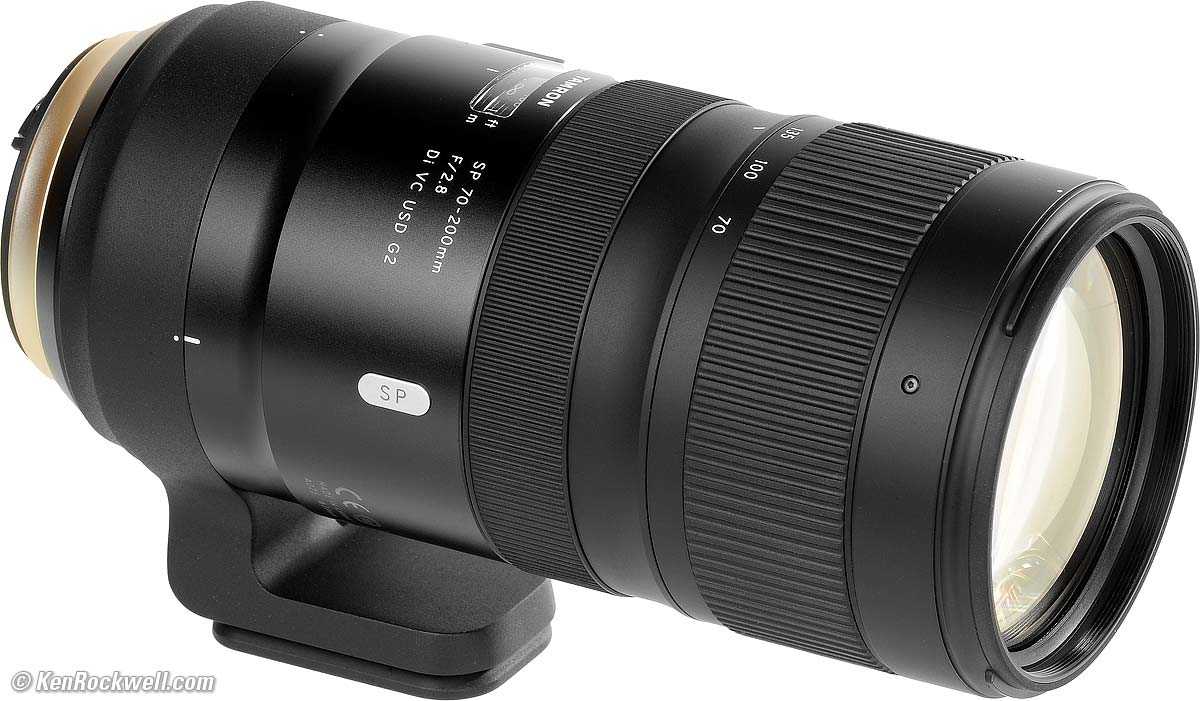
Tamron 70-200mm f/2.8 VC G2 (77mm filters, 52.1 oz./1,477g, 3.1’/0.95m close focus, about $1,299) bigger. I got my Nikon version at B&H. I’d also get the Nikon version at Adorama or at Amazon. There is a Canon version at B&H, which I’d also get at Adorama or at Amazon.
This ad-free websites biggest source of support is when you use those or any of when you get anything, regardless of the country in which you live. Tamron does not seal its boxes in any way, so never buy at retail or any other source not on since you’ll have no way of knowing if you’re missing accessories, getting a defective, damaged, returned, , store demo or used lens. Get yours only from the for the best prices, service, return policies and selection. Thanks for helping me help you! Ken.
April 2018 Sony Zeiss Nikon Canon Fuji LEICA All Reviews
Nikon 70-200mm f/2.8 FL VR FX (check price)
Nikon 80-200mm f/2.8D FX (check price)
Canon 70-200mm f/2.8 L IS II (check price)
Canon 100-400mm L IS II (check price)
Sample Images
All these images are from BASIC JPGs; no RAW files, NORMAL or FINE JPGs were used.

Boulevards, 13 April 2018, Friday. Nikon D850, Tamron 70-200mm f/2.8 G2 at 120mm at f/5.6 at 1/250 at Auto ISO 64, Perfectly Clear. bigger or full-resolution or camera-original file.

Sofie, 18 April 2018, Wednesday. Cropped from horizontal Nikon D850 file, Tamron 70-200mm f/2.8 G2 at 125mm at f/8 at 1/250 at Auto ISO 64, as shot. bigger or camera-original file.

Zoey, 18 April 2018, Wednesday. Cropped from horizontal Nikon D850 file, Tamron 70-200mm f/2.8 G2 at 200mm at f/8 at 1/250 at Auto ISO 64, as shot. bigger or camera-original file.
Alternatives
– From the third-party manufacturers there’s only one alternative: The Sigma AF 70-200mm 2.8 EX DG APO HSM OS is the cheapest way (around 950 EUR) to get a stabilized 70-200mm f2.8 zoom. And it earned a Recommended rating too. See my Sigma 70-200 f2.8 OS review.
– For Nikonians there are two alternatives, both of which I have reviewed: See my AF-S 70-200mm 2.8G ED VR II review for the professional version and my Nikon’s AF-S VR 70-200mm 4.0G ED VR review for the cheaper and lighter version. Both lenses bracket Tamron’s lens in price and earned a Highly Recommended rating in my reviews. So Tamron seems caught between a rock and a hard place.
– For Canon-users there are also two alternatives: The Canon EF 70-200mm 2.8 L IS II USM or the Canon EF 70-200mm 4.0 L IS USM. Similar to Nikon’s offering their f2.8 version is more expensive than Tamron’s zoom, but the f4.0 version is considerably cheaper.
| Alternative 70-200mm lenses | ||||
| Nikon 70-200mm f4 | Sigma 70-200mm f2.8 OS | Nikon 70-200mm f2.8 II | ||
Introduction
|
B&H Photo — Video — Pro Audio I buy only from . I can’t vouch for below. |
This Image-Stabilized Tamron 70-200mm f/2.8 is half the price of Canon or Nikon and works great. Feel free to read the rest of this review, but for all practical purposes this lens takes the same pictures as the Canon or Nikon lenses, with the gotcha that there are no lens profiles so you’ll have no option for automatic in-camera distortion correction, and on Canon only there will be no correction of lateral color fringes or corner falloff (Nikons correct lateral color and falloff with any lens, no profile needed).
Look at my ; they’re super-sharp. If an extra thousand dollars in your pocket matters to you, by all means consider this lens instead of the Canon or Nikon lens. What you lose isn’t so much picture quality as the potential for the camera you buy ten years from now not working with this lens, but if you’re considering this lens today you’re probably not worried about ten or twenty years from now. Even the reviews at Amazon love it.
Just grab the genuine mechanical focus ring at any time for instant manual-focus override.
This is a very nice lens, complete with internal zooming. Nothing moves externally as you zoom and you can flick the genuine mechanical focus ring at any time for instant manual-focus override.
Good
● Sharp.
● Half the price of Canon or Nikon’s similar lenses.
● Same optical performance as Canon’s or Nikon’s 70-200/2.8s.
● Fast and nearly silent autofocus.
● Great stabilization.
Missing
● No lens profiles for in-camera corrections. Nikons can correct any lens for lateral chromatic aberrations and falloff without a profile, but Canon can’t correct these without a profile. No camera can correct this lens’ distortion without a profile — and neither Canon nor Nikon are going to offer profiles for a Tamron lens.
Usage

Tamron 70-200mm f/2.8 VC G2. bigger.
VC MODE/1
This selects what kind of Image Stabilization you’re getting.
Mode 1, the top position, is the usual setting. It stabilizes your photos, as well as your viewfinder image.
Mode 2 is for panning.
Mode 3 offers even better picture stabilization than Mode 1, but it may make the viewfinder image look shakier because it’s optimizing itself to stabilize the captured image instead of also stabilizing the pre-exposure viewfinder image.
Use Mode 1, unless you don’t mind a shakier viewfinder image and aren’t getting the results you want in Mode 1. Mode 2 is only for panning.
VC / ON (OFF)
This activates or deactivates Image Stabilization.
Always leave it on (VC/ON), except if you are on a sturdy tripod (OFF).
AF (MF)
This selects auto (AF) or manual focus (MF).
Always leave it at AF, at which setting you can move the focus ring at any time for instant override.
Only set it to MF if you want to lock it in manual focus.
FULL / ∞-3m
This is a focus limiter that, in the ∞-3m setting, doesn’t let the lens focus any closer than 3 meters (10 feet).
Leave this at FULL, unless the lens is racking all the way in and out hunting for the subject, which you know is at least 3m/10′ away. I doubt you’ll ever need this, unless you’re shooting distant things through an obstruction.
Getting a Legal USA Version
This section applies in the USA only.
In the USA, be sure the serial number on your lens (in tiny black-on-black numbers on the bottom of the zoom ring) matches the serial number on the top of the box and on the warranty papers inside the box, and be sure your box has this six-year USA hologram sticker:

Tamron USA hologram sticker. bigger.
If not, you got ripped off with a gray market version from another country. This is why I never buy anyplace other than from my . You just can’t take the chance of buying elsewhere, especially at any retail store, because non-USA versions have no warranty in the USA, and you won’t even be able to get firmware or service for it — even if you’re willing to pay out-of-pocket for it when you need it!
If a gray market version saves you $400 it may be worth it, but for $200 or less I wouldn’t risk having no warranty or support.
Always be sure to check your box while you can still return it, or just don’t buy from unapproved sources or at retail so you’ll be able to have your camera serviced and get free updated firmware as needed.
Get yours from the and you won’t have a problem, but if you take the risk of getting yours elsewhere, be sure to check everything while you still can return it.
Sample Images
All these images are from BASIC JPGs; no RAW files, NORMAL or FINE JPGs were used.
Boulevards, 13 April 2018, Friday. Nikon D850, Tamron 70-200mm f/2.8 G2 at 120mm at f/5.6 at 1/250 at Auto ISO 64, Perfectly Clear. bigger or full-resolution or camera-original file.
Sofie, 18 April 2018, Wednesday. Cropped from horizontal Nikon D850 file, Tamron 70-200mm f/2.8 G2 at 125mm at f/8 at 1/250 at Auto ISO 64, as shot. bigger or camera-original file.
Zoey, 18 April 2018, Wednesday. Cropped from horizontal Nikon D850 file, Tamron 70-200mm f/2.8 G2 at 200mm at f/8 at 1/250 at Auto ISO 64, as shot. bigger or camera-original file.
Image Quality
I tested the Tamron SP 70-200mm with the 50MP Canon EOS 5DS R, the highest resolution full-frame SLR on the market. At 70mm f/2.8 it puts up top-end numbers, 3,557 lines per picture height on Imatest’s center-weighted sharpness test. Image quality is even from edge to edge.
There’s no significant change in resolution at f/4, but we do see some improvement at f/5.6 (3,890 lines) and f/8 (3,925 lines). Diffraction sets in at narrower apertures, reducing resolution at f/11 (3,649 lines) and f/16 (3,174 lines), but doesn’t become a real issue until f/22 (2,554 lines). That’s a little bit better than the 2,200 lines we want to see at a minimum from a high-resolution camera like the 5DS, but definitely not anywhere near what the lens is capable of at its best.
Image quality improves at 100mm. At f/2.8 the lens scores 3,737 lines, with improvement at f/4 (3,972 lines), f/5.6 (4,104 lines), and f/8 (4,017 lines). As expected, image quality starts to degrade as you stop down further—3,682 lines at f/11, 3,205 lines at f/16, and 2,588 lines at f/22.
Performance remains strong at 135mm. At f/2.8 we see 3,488 lines, which improves steadily as you stop down—3,786 lines at f/4, 3,998 lines at f/5.6, and 4,023 lines at f/8. There’s a slight drop at f/11 (3,770 lines), and a more noticeable one at f/16 (3,281 lines) and f/22 (2,592 lines).
Image quality takes a noticeable hit at 200mm. At f/2.8 the score drops to 2,842 lines. That’s still very good, but it’s not as exceptional as wider angles. There’s an unexpected falloff in clarity at f/4 (2,555 lines)—we ran two separate tests to confirm this wasn’t an issue with focus—and the lens is back up toward its f/2.8 score at f/5.6 (2,739 lines). You get the sharpest photos at f/8 (3,286 lines), and both f/11 (3,470 lines) and f/16 (3,142 lines) net crisper photos than shooting wide open. Of course, stopping down this far limits your ability to shoot in dim conditions and also reduces the amount of background blur in photos. At f/22 the score is in the expected range, 2,525 lines.
There is some distortion. At 70mm we see 1.4 percent barrel distortion, which gives straight lines the appearance of an outward curve. At 100mm and 135mm distortion is a nonissue, but we see 1.1 percent pincushion distortion at 200mm, which gives lines a slight inward curve.
Where distortion is fairly modest, corner dimness is pronounced, giving images shot at f/2.8 and f/4 a noticeable dark vignette. The corners lag behind the center in brightness by about 3 stops (-3EV) when shooting at f/2.8 throughout the zoom range, and the edges are also noticeably dimmer, -1.5EV. Stopping down to f/4 brightens corners, but they are still about -1.5EV dimmer than the center. There’s still a little bit of a vignette effect at f/5.6 (-1.2EV), but it’s gone at f/8 and narrower settings.
Raw photographers are used to using Lightroom CC or similar software to correct distortion and remove an unwanted vignette. But JPG shooters who use first-party glass can simply enable in-camera corrections to compensate for both automatically. If you typically just share out-of-camera JPG shots, you may have some issue with the dimmed corners.
In field testing, I noticed that the lens has a tendency to flare quite noticeably when shooting toward the sun. You can see the effect at its strongest in the above image. I tried several different focal lengths and aperture settings, and got similar flare whenever I pointed the lens at the sky. The Nikon 70-200mm does a much better job controlling the effect. Of course, you may like the look, especially if you’re a fan of shooting backlit portraits; it’s a personal preference.
Introduction
The Tamron SP 70-200mm F/2.8 Di VC USD is a fast telephoto zoom lens for Canon, Sony and Nikon full-frame DSLR cameras. This compact lens features a constant aperture of f/2.8 throughout the range, Vibration Compensation (VC) technology, and an ultrasonic focus motor for quiet AF operation, and a moisture-sealed construction. The optical formula comprises 23 lens elements in 17 groups, including one XLD (Extra Low Dispersion) glass and four LD (Low Dispersion) elements, and an iris diaphragm with nine rounded aperture blades. The Tamron SP 70-200mm F/2.8 Di VC USD lens officially retails for £1,399.99 / $1499.
Tamron SP 70-200mm F2.8 Di VC USD Introduction
The Tamron SP 70-200mm F/2.8 Di VC USD is a fast telephoto zoom lens for Canon, Sony and Nikon full-frame DSLR cameras. This compact lens features a constant aperture of f/2.8 throughout the range, Vibration Compensation (VC) technology, and an ultrasonic focus motor for quiet AF operation, and a moisture-sealed construction. The optical formula comprises 23 lens elements in 17 groups, including one XLD (Extra Low Dispersion) glass and four LD (Low Dispersion) elements, and an iris diaphragm with nine rounded aperture blades. The Tamron SP 70-200mm F/2.8 Di VC USD lens officially retails for £1,399.99 / $1499.
Focus, build quality, and image stabilization
Focus accuracy and repeatability is critical to consistently produce sharp shots. Repeatability (the accuracy of focus on the same subject after repeated focus-acquisition) of this lens is good with only one outlier over a series of 120 shots. And there is no performance variation whether the lens focuses coming from infinity or from minimum focus distance. The lens focuses at around 0.7 sec from infinity to 1.4m which is a little slower than the Nikon 70-200/2.8 at 0.6 sec.
The focus ring has no slack/play between its movement and the focus-action. It has a throw of around 130 degrees, which makes accurate focus wide open up to 150mm easy. The position of the focus ring and the zoom-ring are reversed from their respective positions on the Nikon 70-200/2.8 but at least they turn into the same direction as Nikon’s rings. The focus ring is the smaller of the two but still good enough to grip, movement is a little stiff. Zoom-action is smoother and the throw of the zoom-ring at only 60 degrees is pretty short. AF-operation is audible from the outside, and if you record video with the built-in microphone every focus-movement starts and stops with a slight “tock”. But between starting and stopping the AF-drive can hardly be heard in-between. The VR-system is quiet on the outside on barely records on video. And shaking the lens produces hardly any noises. All-in-all this is the quietest zoom I had so far on the D800.
Focus breathing is very visible: If you focus closer, the viewing angle becomes larger, the magnification smaller.
In general the impression of build quality is that of a pro-level lens: A high quality metal/plastic construction combined with nine rounded aperture blades and weather sealing. The sturdy tripod-collar and mount weighs a massive 185g and can be completely removed from the lens without having to detach the lens from the camera first.
To test the effectiveness of the image stabilization I did a series of over 170 test-shots hand-held at 200mm with VC=ON at 1/50, 1/25 and 1/13 sec and with VC=OFF at 1/200 sec. Rating the sharpness of those images at 100% magnification on a scale from 0 to 5 and comparing the samples of images with VC=ON and VC=OFF indicates that this lens gives you an advantage of about 3 stops.
That is very good! But there was a very irritating “warm-up” phase with the VC: It took about two to three shots at room temperature before VC was properly locking on target. And if you pause for a minute “warm-up” started anew with the first one or two shots being unusable. Unfortunately a second copy of the lens suffered from similar behavior with up to five shots needed for the VC to work as advertised.
So this looks like a design-problem or at least an issue with this batch of lenses. Additionally, on the outside with temperatures near 0 degrees Celsius during my test period I sometimes had the impression the VC didn’t work at all, or at least only after many more warm-up-shots. This renders VC almost useless because you hardly want to lose your first few shots. So if you get your copy of this lens make sure that VC wakes up immediately especially at lower temperatures!
Now it’s time to check out the results in my Tamron 70-200mm f2.8 VC quality and Tamron 70-200mm f2.8 VC sample images pages, or if you’d like to skip to chase, head straight for my verdict!

























